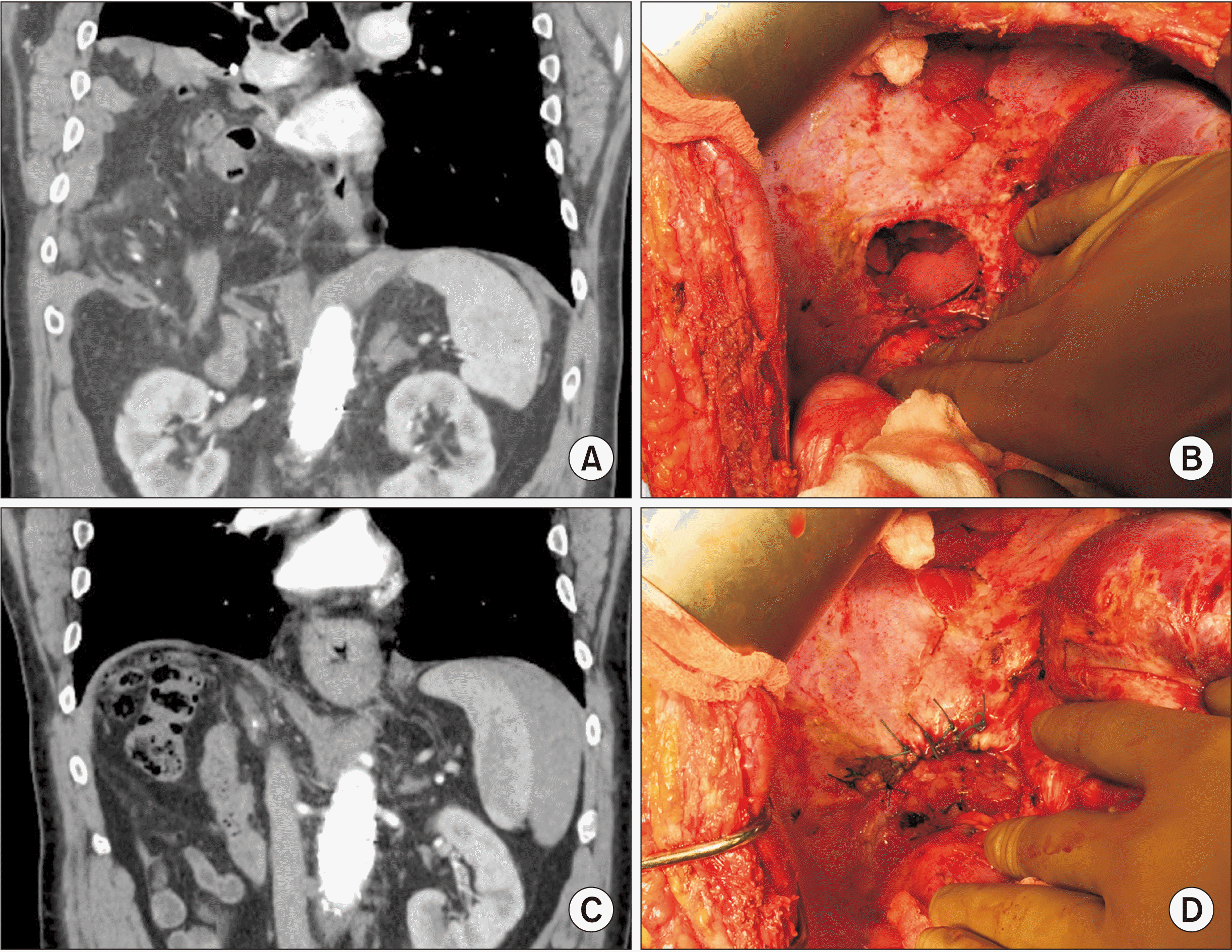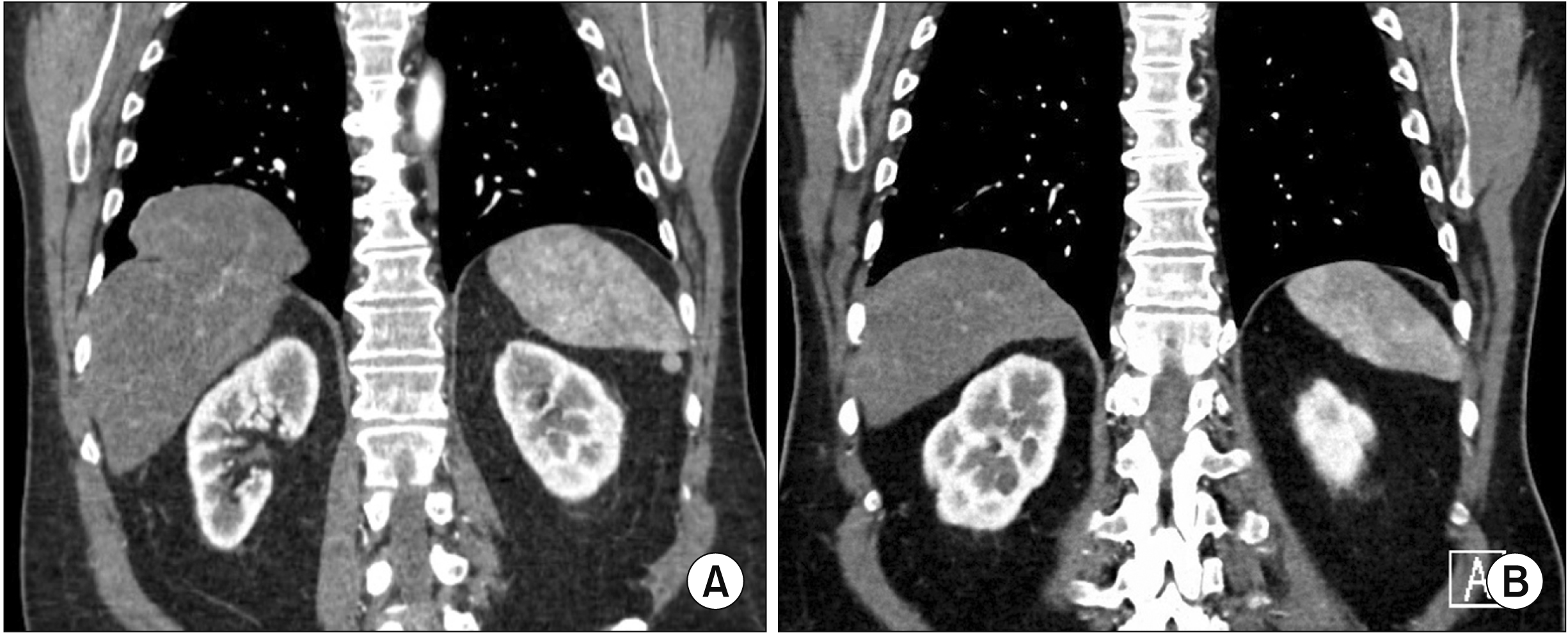1. Kousoulas L, Becker T, Richter N, Emmanouilidis N, Schrem H, Barg-Hock H, et al. 2011; Living donor liver transplantation: effect of the type of liver graft donation on donor mortality and morbidity. Transpl Int. 24:251–258. DOI:
10.1111/j.1432-2277.2010.01183.x. PMID:
21062368.

2. Dieter RA Jr, Spitz J, Kuzycz G. 2011; Incarcerated diaphragmatic hernia with intrathoracic bowel obstruction after right liver donation. Int Surg. 96:239–244. DOI:
10.9738/CC10.1. PMID:
22216703.

3. Tabrizian P, Jibara G, Shrager B, Elsabbagh AM, Roayaie S, Schwartz ME. 2012; Diaphragmatic hernia after hepatic resection: case series at a single Western institution. J Gastrointest Surg. 16:1910–1914. DOI:
10.1007/s11605-012-1982-7. PMID:
22851338.

4. Cortes M, Tapuria N, Khorsandi SE, Ibars EP, Vilca-Melendez H, Rela M, et al. 2014; Diaphragmatic hernia after liver transplantation in children: case series and review of the literature. Liver Transpl. 20:1429–1435. DOI:
10.1002/lt.23977. PMID:
25124299.

5. Livingstone SM, Andres A, Shapiro AM, Kneteman NN, Bigam DL. 2016; Diaphragmatic hernia after living donor right hepatectomy: proposal for a screening protocol. Transplant Direct. 2:e84. DOI:
10.1097/TXD.0000000000000596. PMID:
27830178. PMCID:
PMC5087565.

6. Esposito F, Lim C, Salloum C, Osseis M, Lahat E, Compagnon P, et al. 2017; Diaphragmatic hernia following liver resection: case series and review of the literature. Ann Hepatobiliary Pancreat Surg. 21:114–121. DOI:
10.14701/ahbps.2017.21.3.114. PMID:
28989997. PMCID:
PMC5620471.

7. Oh JW, Oh SN, Jung SE, Byun JY. 2017; Diaphragmatic hernia after living-donor right hepatectomy: an important late donor complication. J Comput Assist Tomogr. 41:726–730. DOI:
10.1097/RCT.0000000000000591. PMID:
28240639.
8. Emamaullee JA, Nekrasov V, Gilmour S, Kneteman N, Yanni G, Kohli R, et al. 2018; Case series and systematic review of acquired diaphragmatic hernia after liver transplantation. Pediatr Transplant. 22:e13296. DOI:
10.1111/petr.13296. PMID:
30280450.

9. Wang K, Gao W, Ma N, Meng XC, Zhang W, Sun C, et al. 2018; Acquired diaphragmatic hernia in pediatrics after living donor liver transplantation: three cases report and review of literature. Medicine (Baltimore). 97:e0346. DOI:
10.1097/MD.0000000000010346. PMID:
29642174. PMCID:
PMC5908575.
10. Manzini G, Kuemmerli C, Reiner CS, Petrowsky H, Gutschow CA. 2019; Enterothorax after hepatic surgery: a single-center experience. World J Surg. 43:902–909. DOI:
10.1007/s00268-018-4838-9. PMID:
30386912.

11. Karakas S, Sahin TT, Kutluturk K, Otan E, Baskiran A, Sarici KB, et al. 2020; Diaphragmatic hernias after pediatric liver transplantation: experience of a high-volume transplant center. Pediatr Transplant. 24:e13684. DOI:
10.1111/petr.13684. PMID:
32166863.

13. Lochan R, Saif R, Ganjoo N, Sakpal M, Panackal C, Raja K, et al. 2017; Diaphragmatic herniation following donor hepatectomy for living donor liver transplantation: a serious complication not given due recognition. Ann Hepatobiliary Pancreat Surg. 21:232–236. DOI:
10.14701/ahbps.2017.21.4.232. PMID:
29264588. PMCID:
PMC5736745.

14. Hawxby AM, Mason DP, Klein AS. 2006; Diaphragmatic hernia after right donor and hepatectomy: a rare donor complication of partial hepatectomy for transplantation. Hepatobiliary Pancreat Dis Int. 5:459–461. PMID:
16911950.
15. Perwaiz A, Mehta N, Mohanka R, Kumaran V, Nundy S, Soin AS. 2010; Right-sided diaphragmatic hernia in an adult after living donor liver transplant: a rare cause of post-transplant recurrent abdominal pain. Hernia. 14:547–549. DOI:
10.1007/s10029-009-0594-y. PMID:
19957001.

16. Dieter RA Jr. 2011; Postoperative right diaphragmatic hernia with enterothorax in live liver donors. Exp Clin Transplant. 9:353. PMID:
21967265.
17. Vernadakis S, Paul A, Kykalos S, Fouzas I, Kaiser GM, Sotiropoulos GC. 2012; Incarcerated diaphragmatic hernia after right hepatectomy for living donor liver transplantation: case report of an extremely rare late donor complication. Transplant Proc. 44:2770–2772. DOI:
10.1016/j.transproceed.2012.09.014. PMID:
23146519.

18. Mizuno S, Tanemura A, Isaji S. 2014; Incarcerated left diaphragmatic hernia following left hepatectomy for living donor liver transplantation. Transpl Int. 27:e65–e67. DOI:
10.1111/tri.12289. PMID:
24661256.

19. Jeng KS, Huang CC, Lin CK, Lin CC, Wu JM, Chen KH, et al. 2015; Early incarcerated diaphragmatic hernia following right donor hepatectomy: a case report. Transplant Proc. 47:815–816. DOI:
10.1016/j.transproceed.2015.02.001. PMID:
25891737.

20. Takaichi S, Takahashi T, Funaki S, Tanaka K, Miyazaki Y, Makino T, et al. 2018; Laparoscopic repair of an incarcerated diaphragmatic hernia after right hepatectomy for hepatic injury: a case report. Surg Case Rep. 4:135. DOI:
10.1186/s40792-018-0542-0. PMID:
30456575. PMCID:
PMC6242806.

21. McCabe AJ, Orr JD, Sharif K, De Ville de Goyet J. 2005; Right-sided diaphragmatic hernia in infants after liver transplantation. J Pediatr Surg. 40:1181–1184. DOI:
10.1016/j.jpedsurg.2005.03.063. PMID:
16034767.

22. Earl TM, Wellen JR, Anderson CD, Nadler M, Doyle MM, Shenoy SS, et al. 2011; Small bowel obstruction after pediatric liver transplantation: the unusual is the usual. J Am Coll Surg. 212:62–67. DOI:
10.1016/j.jamcollsurg.2010.09.017. PMID:
21123094.

23. Moon SB, Jung SM, Kwon CH, Kim SJ, Joh JW, Seo JM, et al. 2012; Posteromedial diaphragmatic hernia following pediatric liver transplantation. Pediatr Transplant. 16:E106–E109. DOI:
10.1111/j.1399-3046.2010.01462.x. PMID:
21235708.

24. Shigeta T, Sakamoto S, Kanazawa H, Fukuda A, Kakiuchi T, Karaki C, et al. 2012; Diaphragmatic hernia in infants following living donor liver transplantation: report of three cases and a review of the literature. Pediatr Transplant. 16:496–500. DOI:
10.1111/j.1399-3046.2012.01722.x. PMID:
22672688.

25. Lee S, Seo JM, Younes AE, Oh CY, Lee SK. 2015; Thoracoscopic approach for repair of diaphragmatic hernia occurring after pediatric liver transplant. Medicine (Baltimore). 94:e1376. DOI:
10.1097/MD.0000000000001376. PMID:
26287426. PMCID:
PMC4616449.

26. Yeung F, Chung PH, Wong KK, Tam PK. 2015; Iatrogenic diaphragmatic hernia in paediatric patients. Pediatr Surg Int. 31:589–592. DOI:
10.1007/s00383-015-3702-3. PMID:
25899934.

27. Lam HD, Mejia J, Soltys KA, Sindhi R, Mazariegos G, Bond G. 2013; Right diaphragmatic hernia after liver transplant in pediatrics: a case report and review of the literature. Pediatr Transplant. 17:E77–E80. DOI:
10.1111/petr.12052. PMID:
23442132.

28. Bonatti H, Muiesan P, Connelly S, Baker A, Mieli-Vergani G, Gibbs P, et al. 1997; Hepatic transplantation in children under 3 months of age: a single centrés experience. J Pediatr Surg. 32:486–488. DOI:
10.1016/S0022-3468(97)90612-6.
29. Englert C, Helmke K, Richter A, Beckmann M, Rogiers X, Burdelski M, et al. 2006; Diaphragmatic hernia resulting in enterothorax following pediatric liver transplantation: a rare complication. Transplantation. 82:574–576. DOI:
10.1097/01.tp.0000231709.63721.5c. PMID:
16926604.

30. Okajima H, Hayashida S, Iwasaki H, Suda H, Takeichi T, Ueno M, et al. 2007; Bowel obstruction due to diaphragmatic hernia in an elder child after pediatric liver transplantation. Pediatr Transplant. 11:324–326. DOI:
10.1111/j.1399-3046.2006.00658.x. PMID:
17430491.

31. Kazimi M, Ibis C, Alper I, Ulas M, Baran M, Arikan C, et al. 2010; Right-sided diaphragmatic hernia after orthotopic liver transplantation: report of two cases. Pediatr Transplant. 14:e62–e64. DOI:
10.1111/j.1399-3046.2009.01168.x. PMID:
19344340.

32. Dökümcü Z, Divarcı E, Erdener A, Sözbilen M, Ergün O. 2015; Acquired right diaphragmatic hernia following pediatric living donor orthotopic liver transplantation. Pediatr Transplant. 19:E149–E151. DOI:
10.1111/petr.12548. PMID:
26101838.

33. Kirnap M, Akdur A, Ozcay F, Soy E, Coskun M, Moray G, et al. 2015; Diaphragmatic hernia after pediatric liver transplant. Exp Clin Transplant. 13:471–474. DOI:
10.6002/ect.mesot2014.P113. PMID:
25894173.
34. Yazdani M, Park E, Udayasankar U. 2016; Postsurgical diaphragmatic herniation: a rare delayed complication of pediatric intraabdominal surgery. J Pediatr Surg. 51:333–335. DOI:
10.1016/j.jpedsurg.2015.11.019. PMID:
26743345.

35. Okur MH, Yankol Y, Mecit N, Hoş G, Ertugrul G, Kanmaz T, et al. 2018; Diaphragmatic hernia after liver transplant in children: report of 2 cases. Exp Clin Transplant. 16:337–339. DOI:
10.6002/ect.2016.0110. PMID:
28411361.
36. Cherukuru R, Menon J, Patel K, Thambidurai R, Subbiah K, Shanmugam NP, et al. 2020; Uncommon presentation of a recurrent diaphragmatic hernia after pediatric liver transplantation. Pediatr Transplant. 24:e13790. DOI:
10.1111/petr.13790. PMID:
32678468.





 PDF
PDF Citation
Citation Print
Print





 XML Download
XML Download